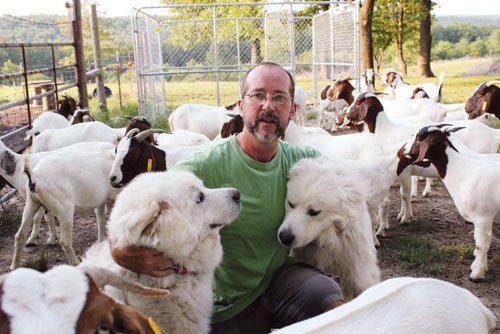Baking Bread
Nothing smells quite so good as the aroma of baking bread in the oven.
And the incomparable taste and texture of a loaf of wholesome, homemade, preservative free bread is well worth the effort, especially since breadmaking is not nearly as time consuming as many people believe.
Measuring, mixing, kneading, and shaping can be accomplished in 30 minutes or less.
Rising takes longer; but this is a process that occurs by itself, leaving you free to handle other chores or simply to sit back, relax, and contemplate the wr, fresh bread you will soon be enjoying.
What Goes Into a Loaf of Bread and Why?
Bread is a simple food.
Baking bread requires few ingredients and little equipment is required to make it.
The basic components for baking bread are yeast and flour:
yeast to make the dough rise,
flour to provide substance and structure.
b>Yeast Yeast is a plant with millions of tiny living cells and when it is put with warm water, sugar and flour it grows and multiplies.
It gives off carbon dioxide gas that makes dough rise.
Yeast provides vitamins, and gives bread its fresh quality. Yeast contributes to the smell and taste.
You can purchase yeast in two forms. There is the active dry yeast and compressed yeast.
Active dry yeast comes in granulated form and it remains fresh for months without placing it in the refrigerator.
Prior to it’s use, it is usually dissolved in lukewarm 110 degrees milk or water.
Though, it is from time to time added directly to the other dry ingredients and then mixed with the water or milk to some extent at temperatures of 120-130 degrees F.
Compressed yeast comes in cake form and spoils faster:
Refrigerated or freeze immediately.
If refrigerated, it can keep for 10 to 14 days.
If frozen, it will be preserved for longer periods.
When your ready to bake bread, thaw out your yeast at room temperature and use it right away. Dissolve it in water or milk that is warmed to 95 degrees F but not any warmer.
The homesteader made their own yeast
Mix together: 1 cup of mashed potatoes, 1/4 cup of sugar, 2 teaspoons of salt, And mix with 1 cup of warm water (105-115 degrees F.)
Empty the mixture into a 1 quart glass jar, and cover it with a cloth. Leave it in a warm place (80-85 degrees F.) for 2 days until it bubbles and ferments.
One cup of this concoction equals one package of active dry yeast or one cake of compressed yeast.
When you use a cupful, make sure that you replenish the starter by stirring in 3/4 cup of flour and 3/4 cup of potato water.
Allow this to ferment for a day or so, cover it, and put back into the refrigerator.
Best practice is to use your starter once a week.
If you don’t, stir it down after three or four weeks, throw away half of it, and refill the balance with flour and one of the liquids.
Baking bread is an enjoyable experience and children love to help too!!!
Flour is the structure that holds the gases that yeast emits.
Bread flour, also known as hard wheat flour, is rich in gluten and makes loaves of greater volume rather than other flours.
Bakeries and health food stores sometimes sell hard wheat flour.
All purpose flour is broadly obtainable and is suitable for both yeast and quick breads.
Buy All Purpose Flour unbleached, which gives a better texture to the baking bread.
If you use rye, whole wheat, and buckwheat flour, they are low in gluten and have to be combined with all purpose flour.
If you use them by themselves, you will get a heavy compact type of bread.
More Ingredients:
In addition, salt, sweetener, shortening, and eggs are frequently used in baking bread recipes.
Salt will add flavoring and controls the yeast action.
Sweeteners will add flavor, assist in browning, and supply food for the yeast.
White cane sugar is the kind most often used, but brown sugar, honey, and molasses can be a substitute in a lot of recipes.
Shortening, usually butter or lard, provides extra flavor, and makes bread extra tender, improving the keeping quality, and helps the appearance in browning..
Eggs provide yeast breads color, texture, and taste.
Though, dough that is enriched with shortening or eggs will take longer to rise.
Special Equipment
Quite a few baking bread pans and maybe a heavy duty mixer are the only particular equipment that is required.
The dimension and shape of the baking pan is essential, so make sure you use the one specific to your recipe.
If the pan is to big, the dough will expand properly but will not rise over the top of the baking pan to make a spectacular looking loaf.
If the pan is to little, the dough will expand to high and glide over the sides of the baking pan.
As a general rule, the dough ought to fill two-thirds of the baking pan.
A number of knowledgeable bakers favor dark colored baking bread pans to help soak up heat and give a browner crust to the bread.
Aluminum pans are satisfactory but black steel pans are best.
It is recommended to darken aluminum bread pans for five hours at 350 degrees F. before using them.
Heat resistant glassware is also popular bread pans. If you would like to try a special recipe of Easily Bake Healthy Whole Wheat Bread. You can learn Step-by-Step How
You Can Improve Your Health, Lose Weight & Save Money By Baking Your Own Healthy Bread! Click Here! to learn more.
Return from Baking Bread to Country Cooking Recipes







